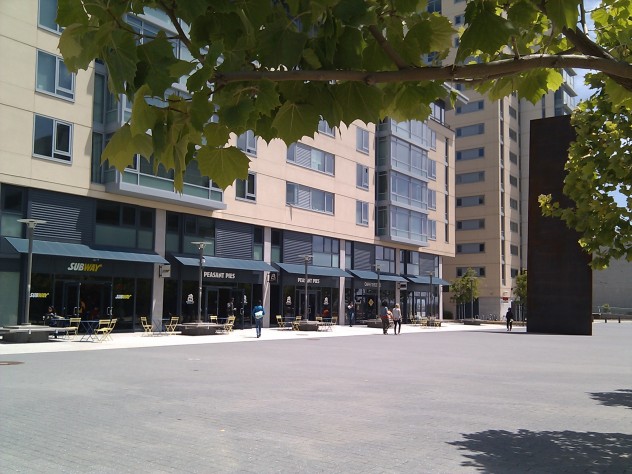Sabbatical Part 1 – UCSF
I was on sabbatical from January 20th till July 12th. Half at Stanford and half at UCSF. All California.
When I was organizing the trip I asked the (now) Dean of Science at Sydney, Trevor Hambley, what a sabbatical was for. My assumption was that it was about going to a new lab, learning a new skill and building new collaborations. Interestingly, he said “the idea is to re-charge.”
Having been, and come back, I understand what he meant, and he was right. Life should be like a sabbatical. A new technique, or a new collaboration, may be useful, but what’s really important is to reconnect with why you’re doing science, in case years of local administrative duties have clouded your youthful, pristine vision.
Why was I on sabbatical? I wanted to visit two labs, one in asymmetric catalyst discovery and one in drug discovery. These labs needed to be the best in their fields. I wanted to see how catalysts and drugs are discovered. My aim was to see how much of the work is screening and how much is design. My assumption before the sabbatical was: it’s mainly screening, since we can’t design drugs or catalysts yet from first principles. If that was the case, I wanted to try to find examples of projects that, if successful, would allow more design and less screening. In the course of this search I also wanted to think about our open science work, and find people who wanted to work this way.
I’ll write about Stanford later. My hosts at UCSF were James McKerrow and Conor Caffrey. They work at the Mission Bay Campus of UCSF, which is not in the middle of the city with the rest of the campus, but is out on the east side where the old port buildings are. It’s an odd place – a beautiful set of buildings surrounded by a view of the city (north), the water (east), wasteland-then-cool Potrero Hill (south) and outskirts of the city (west). Huge tracts of land are waiting for new buildings. You can smell the sea air. It’s a great place for an apartment, if you don’t need to buy anything. I’d like to live there.
I was a guest in the QB3, specifically at the Sandler Center, which has a focus on finding new medicines for neglected tropical diseases, and which supports open science. I was there due to my interest in schistosomiasis. I had also heard that UCSF Mission Bay was a unusually fertile place, scientifically.
And so it was. I had a desk and an internet connection in Byers Hall with a nice view that allowed me to contemplate the stately motion of sea freight. I had to do a number of things like writing grants and papers, but in between times I was able to sit in on the McKerrow group meetings and talk to faculty and students in the building. This was pretty much perfect – it was great to talk with Andrej Sali, Brian Shoichet, Jo Derisi, Adam Renslo and others at various points, and to sit next to Joseph Mulvaney (from the SMDC) the whole time whom I must thank for being so quiet (and answering a few dumb questions I had about cheminformatics).
A few things are really unusual about Mission Bay. The groups have fluid barriers between them. It’s never clear who is working for whom, and people often seem to go to various group meetings because there are so many collaborative projects. The faculty are working on big, interesting problems together in a highly interdisciplinary way. In my experience “interdisciplinary” is a word that people try to tape over an existing department or insert into a planning document. At UCSF it really seemed to be the way people worked.
The thing that really stood out for me was the intellectual independence of the students in the McKerrow group. At group meetings they had a very good level of understanding not only of their work but also of the context of their work in the field. They really were driving their research. The students also were excellent at questioning each other in group meetings, and not leaving this up to those in charge. Perhaps this is a feature of the US, or that it’s an elite organization, or that the research is in biology, or something. Whatever, Jim seems to be fostering a group or people who are turning into proper scientists, with a high level of control over their intellectual futures. A great place to go to graduate school.
The building itself was very attractive – Byers Hall is linked to Genentech Hall by a vertiginous atrium, and there was occasionally music there, or some other event, to mix stuff up.
Over the way was a Peasant’s Pies that lots of people went to, maybe for the pies, maybe for the high quality heavy wooden furniture, maybe for the free wifi. Who knows. People were clearly writing their whole theses in there.
We also witnessed the Byers Bash, where groups of students/faculty got together in a musical competition. People made great music, with food and beer. Jim himself unleashed his inner rock star on guitar and vocals.
I’d never seen anything quite like this place before. Nor could I imagine seeing a communal arcade machine in an academic building in Sydney. Fishtanks flank it.
If anyone in Sydney has an old Pacman machine going spare, we can find a good home for it in my lab.
So screening vs. design? A big question with a long answer. I’ll come back to it.






Reply